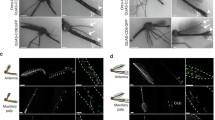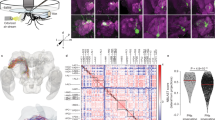Abstract
Anopheles gambiae and Toxorhynchites brevipalpis represent the nocturnal and diurnal extremes of the mosquito light intensity range, and their eyes are structurally very different. A. gambiae has fused rhabdoms with huge acceptance angles, whereas T. brevipalpis has open rhabdoms with rhabdomere acceptance angles comparable with those of advanced (brachyceran) flies. Here, we show that the retina-lamina projections are consistent with these differences. The short receptor axons from each ommatidium in A. gambiae insert as a group between four lamina monopolar cell clusters. In T. brevipalpis axon bundles from each ommatidium undergo a twist in their passage through the nuclear layer of the lamina, and then fan out into a space the diameter of which is about twice the separation of the monopolar cell clusters. This arrangement is consistent with a neural superposition mechanism closely similar to that found in higher Diptera, but which must have evolved independently.








Similar content being viewed by others
References
Blest AD, Davie PS (1980) Reduced silver impregnations derived from the Holmes technique. In: Strausfeld NJ, Miller TA (eds) Neuroanatomical techniques: insect nervous systems. Springer, Berlin Heidelberg New York, pp 98–118
Braitenberg V (1967) Patterns of projections in the visual system of the fly 1. Retina-lamina projections. Exp Brain Res 3:271–298
Brammer JD (1970) The ultrastructure of the compound eye of the mosquito Aedes aegypti L. J Exp Zool 174:181–195
Dietrich W (1909) Die Facettenaugen der Dipteren. Z Wiss Zool 92:465–539
Harbach RE, Kitching IJ (1998) Phylogeny and classification of the Culicidae (Diptera). Systematic Entomol 23:327–370
Kirschfeld K (1967) Die Projektion der optischen Umwelt auf das Raster der Rhabdomere im Komplexauge von Musca. Exp Brain Res 3:248–270
Land MF, Gibson G, Horwood J (1997) Mosquito eye design: conical rhabdoms are matched to wide aperture lenses. Proc R Soc Lond B 264:1183–1187
Land MF, Gibson G, Horwood J, Zeil J (1999) Fundamental differences in the optical structure of the eyes of nocturnal and diurnal mosquitoes. J Comp Physiol A 185:91–103
Meinertzhagen IA (1991) Evolution of the cellular organization of the arthropod compound eye and optic lobe. In: Cronly-Dillon JR, Gregory RL (eds) Vision and visual dysfunction, vol 2. Macmillan, Basingstoke pp 341–363
Meinertzhagen IA (1996) Ultrastructure and quantification of synapses in the insect nervous system. J Neurosci Methods 69:59–73
Melzer RR (1994) Optic lobes of the larval and imaginal scorpionfly Panorpa vulgaris (Mecoptera, Panorpidae): a neuroanatomical study of neuropil organization, retinula axons, and lamina monopolar cells. Cell Tissue Res 275:283–290
Melzer RR, Zimmermann, Smola U (1997) Modification of dispersal patterns of branched photoreceptor axons and the evolution of neural superposition. Cell Mol Life Sci 53:242–247
Nilsson DE, Ro A-I (1994) Did neural pooling for night vision lead to the evolution of neural superposition eyes?. J Comp Physiol A 175:289–302
Nonidez JF (1939) Studies on the innervation of the heart. Am J Anat 65:361–413
Rowell CHF (1963) A general method for silvering invertebrate nervous systems. Q J Micr Sci 104:81–87
Seifert P, Smola U (1990) Adaptive structural changes indicate an evolutionary progression towatds the open rhabdom in Diptera. J Evol Biol 3:225–242
Shaw SR (1989) The retina-lamina pathway in insects, particularly Diptera, viewed from an evolutionary perspective. In: Stavenga DG, Hardie RC (eds) Facets of Vision. Springer, Berlin Heidelberg New York, pp 186–212
Shaw SR (1990) The photoreceptor axon projection and its evolution in the neural superposition eyes of some primitive brachyceran Diptera. Brain Behav Evol 35:107–125
Strausfeld NJ, Nässel DR (1981) Neuroarchitectures serving compound eyes of crustacea and insects. In: Autrum H (ed) Handbook of sensory physiology, vol VII/6B. Springer, Berlin Heidelberg New York, pp 1–132
Zeil J (1979) A new kind of neural superposition eye: the compound eye of male Bibionidae. Nature 278:249–250
Zeil J (1983) Sexual dimorphism in the visual system of flies: the compound eyes and neural superposition in Bibionidae (Diptera). J Comp Physiol 150:379–393
Acknowledgments
We are grateful to Barbara Sawyer of the London School of Hygiene and Tropical Medicine, and Dr G.G. Gibson of Natural Resources Institute, Chatham for the supply of mosquitoes. Professor Ian Meinertzhagen (Dalhousie) gave us much useful advice and read and commented on the manuscript. This work was performed with the aid of a grant (85/S11445) from the Biotechnology and Biological Sciences Research Council of the UK.
Author information
Authors and Affiliations
Corresponding author
Rights and permissions
About this article
Cite this article
Land, M.F., Horwood, J. Different retina-lamina projections in mosquitoes with fused and open rhabdoms. J Comp Physiol A 191, 639–647 (2005). https://doi.org/10.1007/s00359-005-0616-x
Received:
Revised:
Accepted:
Published:
Issue Date:
DOI: https://doi.org/10.1007/s00359-005-0616-x




